Ganesha, Lord of Beginnings
In the Hindu tradition there are many symbolic representations of divinity, and it would be very easy to become confused by the different representations of God, but it is very important to remember that all representations of God are merely symbolic images, forms that the formless will assume in order to aid his devotees.
In reality, God is formless. What we call "God" has no form or name. God is.
Even the word "God" bears a heavy burden of assumptions, beliefs, theories, conflicts, wars, and violence. Really, the word "God" is not accurate either. That is why in the Gnostic tradition we use the term Absolute, because it more accurately represents the nature of that which is, from which everything emerges.
In every religion, the primordial source of all existence is represented in many different ways. Those representations change according to time, psychology, and other factors. We began this course about the Teachings of the Hindu Gods talking about Krishna, but the reality is that Krishna is symbolic, and we could easily use any of the other Hindu Gods to talkabout the Absolute, how that nothingness becomes something. In certain traditions of Hinduism, this has been the case, that instead of calling that Absolute of nature Krishna, they call it other names; some call it Brahma, which is equally accurate and valid, others call it Shiva, or Vishnu, or Ganesha, or Prakriti, or Kali or Durga. All of these names are accurate, because God is not a multiplicity, it is a unity as a multiplicity. All these forms and appearances of God are one and the same, they are forms that represent appearance out of non-appearance, out of a nothingness.
In the previous lectures we talked about how Prakriti ("nature") has two primary aspects: the unmanifested and the manifested. These levels of nature are really important to understand if you want to have any understanding of Divinity, God, reality, because at the heart of everything that exists is an non-existence. It is an absolute state, which is without attributes, which is beyond any sort of conception or belief, but is a state of pure undifferentiated joy and unity. Cognizance of that formless level of life is the ultimate goal of all religions and spirituality. This point cannot be overestimated. Unfortunately in many traditions people have built forms, idols, of the Gods in their minds and hearts, and fail to see that the idol is a symbol that represents something formless.
When we talk about Krishna, Durga, Lakshmi, or any of the Hindu gods, all of these symbols are doorways into ourselves, into the deepest regions of our true nature. Our inner nature has these levels of manifested and unmanifested nature, within us, not outside of us. The purpose of religion is reflected in the origin of that word, religare, which means "to reunite or to bind, to reconnect," and is identical to the Hindu term yoga, which comes from yug, which means "to unite," and is where we get the word "yoke." Our purpose is not to unite with some image of a God or to enslave ourselves to some doctrinal demands to behave a certain way in order to be a true follower of such and such symbol. Our true purpose is to be a manifestation of the unmanifested, to become a God on Earth. The whole purpose of Divinity is to make us a reflection of It. That is why we are alive: to become divine.
When we study any religion, this point of view is absolutely critical to bear in mind. It is the loss of this point of view that has caused the decay and corruption of every religion on the face of the Earth. We have become trapped in Avidya, ignorance (a-, "without" and vidya, "knowledge or gnosis"). Avidya is ignorance, it is a lack of knowledge. The chief meaning of Avidya is a lack of genuine self-knowledge. We do not know ourselves. That is why we become trapped in politics, religions, materialism, and the pursuit of possessions, money, and sex, and we die and are reborn continually, because we fail to recognize the truth which is the unmanifested within us. The truth is far beyond any symbolic representation of God.
The true devotee of any symbolic of God seeks to go beyond the symbol, seeks to become it. Some traditions have a form of practice that we can call Deity Yoga, a means to unite with a Deity by recognizing that our true nature is that Deity. The basis of all yoga (whether Hindu, Buddhist, or any other tradition) is to seek to become like God, and this is why Jesus said,
"Be ye perfect, as your father in Heaven is perfect."
That is pure Deity Yoga, pure Bhakti Yoga. to seek that perfection requires that we seek out our imperfection and remove it. This is not an easy task. Success in religion does not come by beliefs, by dressing a certain way, or attending certain temples, it comes through a rigorous psychological analysis of ourselves.
Ganesha is one of the most easily recognizable Gods from any religion, because he has the head of an elephant. This elephant-headed God appears very widely throughout all Hindu traditions. On that note let me re-emphasize once again that Hinduism is not a single religion, it is a very wide collection of faiths. The true name for Hinduism is Dharma, which means "truth."
Ganesha is one of the "Gods" known throughout Asia, and is becoming known in the West. He has many, names and symbols, and a great deal of importance and emphasis in the traditions of Asia, not just in India but also in China and Japan.
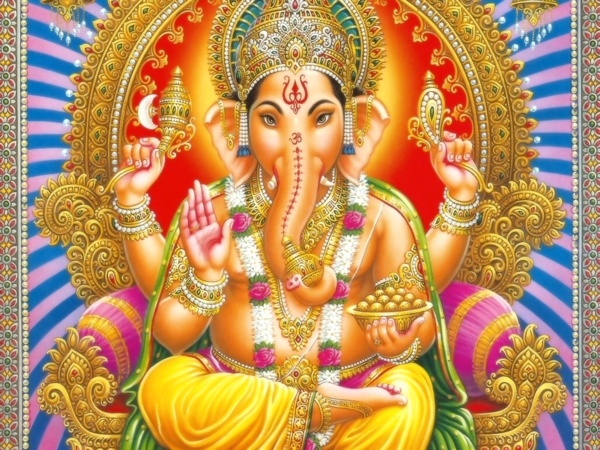
Remover of all obstacles,
Pranava Swaroopi,
Embodiment of wisdom,
Devata of Muladhara Chakra!
O Lord Vinayaka,
The bestower of happiness
Who has Modaka in hand!
O Elephant-headed Lord!
Salutations unto Thee.
Om Gam Ganapataye Namaha.
Names of Ganesha
Ganesha means "Lord of hosts." If you have studied Christianity or Judaism this will sound familiar to you, because "lord of hosts" appears throughout the Bible.
The Sanskrit name "Lord of hosts" is derived from:
- gana means "hosts, group, collection, or categories." It can also be armies, any large number of things or people
- Isha means "Master"
Gana+Isha is "Master of hosts."
Another name for him used throughout India is Ganapati. The name Ganesha is used mostly in northern Indian traditions, while Ganapati is used in the south; yet, Ganapati also means "Lord of hosts."
Another important name for Ganesha is Vinayaka, and this name means "without a master." This refers to not one who avoids having a master, but one who excels all masters; there is no master higher, in other words, he is his own master.
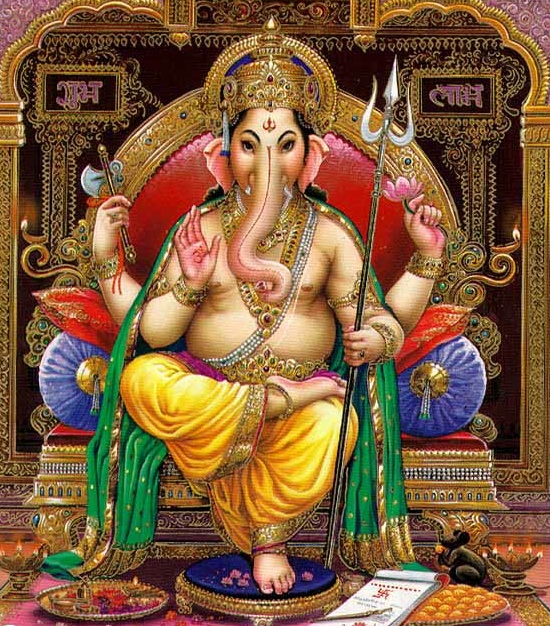
This is a very typical image of Ganesha; he has a pot-belly, a trident, and other tools in his hands. The most significant symbols that we see other than the elephant head are the trident on his forehead and the letter OM on his palm. Sometimes the OM is on his forehead. You also see a mouse at his feet. Sometimes he is holding sweets, little candies, or rice bowls in his hands.
There are many stories about how Ganesha was born his origin, how he received his elephants head, how he is related to the mouse, and many other stories, there are many many volumes of stories about Ganesha, but we do not have time in this lecture to talk about all of that. I encourage to study it all, but for us to understand what Ganesha represents we have to go deep into his symbolism.
Another important name for Ganesha is Vighnaharta; this is probably the way he is most known in Hinduism. Vighnaharta means "remover of obstacles." What is not commonly known especially in the West by people who are trying to learn Hinduism is that he is not simply the remover of obstacles but also the placer of obstacles (Vighnakarta, "obstacle creator"). Not only is he invoked to remove obstacles, but he is the one who puts them there in the first place!
If you know anybody who is Hindu or you go to a Hindu temple, ritual, or festival, they always begin by invoking Ganesha with prayers, mantras, and songs. Every significant event in the life of a Hindu begins with the invocation of Ganesha. This is how important Ganesha is in Hinduism, and why he is called "the lord of beginnings." Devotees ask Ganesh to remove any obstacles, to clear the way so that the goal of the congregation or the person can be achieved.
Another name for Ganesha is Buddhipriya, which means "fond of Buddhi."
Another name is Ekadanta, which means "one tusked."
There are many stories about his tusks. In the earliest myths, Ganesh has a single tusk, and this symbolic representation has been explained in many different ways. Ekadanta has the suffix danta, from dantin, from the root dru- darshayati: "to show"; he has a symbolic single tusk because he is the one who shows the path, who shows the single way to God, and that is Ganeshas: role to clear obstacles and show the path.
That relates to another of his names, Vakratunda, which means "he who straightens out the crooked." Many Hindus think that this all relates to terrestrial life, such as if you going to take a trip or you need to have success in your business or marriage, then you ask Ganesha to bless your marriage or business. That is all good, but the real purpose of the symbol of Ganesha is related to spirituality. "He who straightens the crooked" is he who straightens us, because we are crooked; we are crooked with pride, lust, anger, and many other problems, so with his single tusk he points out the way. To help us, he places obstacles in our way so that we will see our pride and lust, so that we will see that we have forgotten Divinity. Ganesh is a symbol of that part of God in us who puts obstacles in our way in order to teach us about God.
Ganesha is depicted as the child of Shiva and Shakti (Parvati, Uma). As I explained in the previous lecture about the Divine Mother, Shiva and Shakti are a symbolic representation of the Third Logos, Binah in Kabbalah, which is the aspect of the superior trinity that creates. In Buddhism, this is known as the Nirvanakaya, the body of formation, that level of Divinity that creates. Ganesh is the child of the union of Shiva and Parvati.
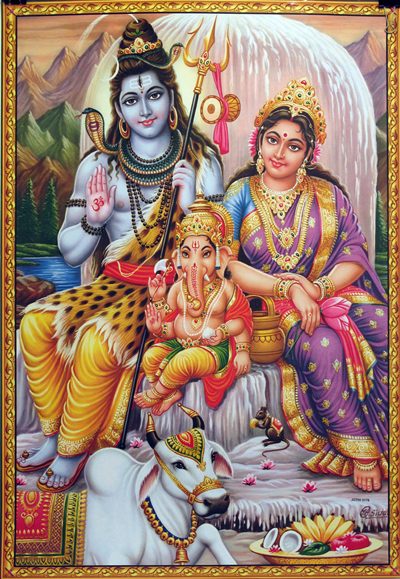
Here Shiva has a trident and an OM on his hand, he gives these to his son Ganesha. Parvati also infuses her power into her child, so Ganesha represents the collected power of Shiva and Parvati.
We see this symbolism in Egypt as well; this trimurti or trinity is represented as Osiris and Isis who have a son Horus. In the Egyptian mythology, Horus is the same symbol as Ganesha. He is a son of God, an embodiment of Divinity who has a mission to accomplish in order to serve Divinity and act as their agent.
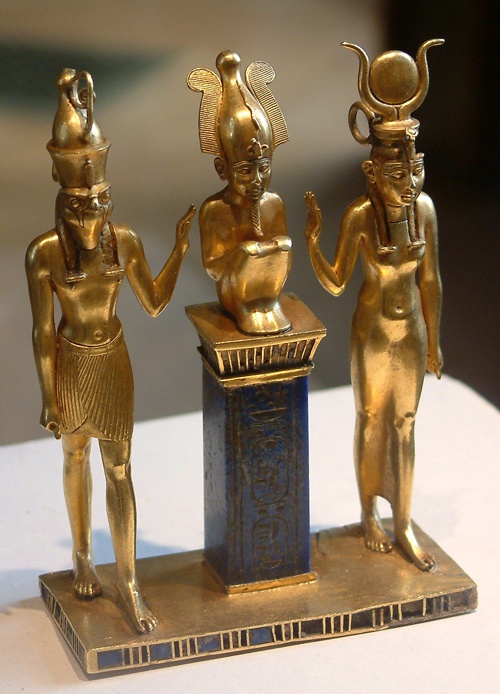
Ganesha means "lord of hosts," and thus he is the general of Shiva's armies. He is in charge of Shiva's military. All of the angels who battle against the demons are under Ganesha's command.
Ganesha is also represented as the bringer of wealth and prosperity; many Hindus worship Ganesha because they want money. This is mistaken. Many Hindus worship Ganesha because they want success in business or power in the world. Unfortunately, they do not understand what Ganesha is and is not.
Ganesha is also represented as the source of all wisdom and knowledge. Throughout many Asian countries, when students begin studies in school, the first thing they learn is a Ganesha mantra so they can chant the mantra when they are doing tests and preparing for their exams in order to try to get Ganesha's help to do well in school. It is great that kids learn that. I wish students would learn that way in the West, to learn in all activties to appeal to God. But, ultimately, the knowledge and intelligence that Ganesha represents is not terrestrial, book knowledge. His knowledge is spiritual.
Why Ganesh Has an Elephant Head
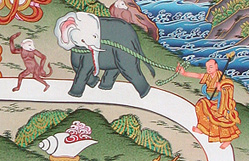 There are many stories that explain why Ganesha has an elephant head; many of the stories are cute, children-oriented stories that are very clever, but they do not explain the real reason behind the elephant head. The reason that Ganesha has an elephants head is because of the symbolism of the elephant in Asian mythology: it relates to the mind. You may know that the painting used to teach concentration practice in Tibetan Buddhism uses an elephant to represent the wild mind that we must learn to manage.
There are many stories that explain why Ganesha has an elephant head; many of the stories are cute, children-oriented stories that are very clever, but they do not explain the real reason behind the elephant head. The reason that Ganesha has an elephants head is because of the symbolism of the elephant in Asian mythology: it relates to the mind. You may know that the painting used to teach concentration practice in Tibetan Buddhism uses an elephant to represent the wild mind that we must learn to manage.
Moreover, if you look at the shape of the letter OM, you can see the shape of an elephants head as in a profile view; you can see a big ear and the face, and sometimes the way its drawn you can see the trunk. This is why Swami Sivananda said:
"Lord Ganesha represents Om or the Pranava, which is the chief Mantra among the Hindus. Nothing can be done without uttering it. This explains the practice of invoking Ganesha before beginning any rite or undertaking any project. His two feet represent the power of knowledge and the power of action. The elephant head is significant in that it is the only figure in nature that has the form of the symbol for Om."
Pranava is a Sanskrit term referring to OM.
The Pranava: AUM
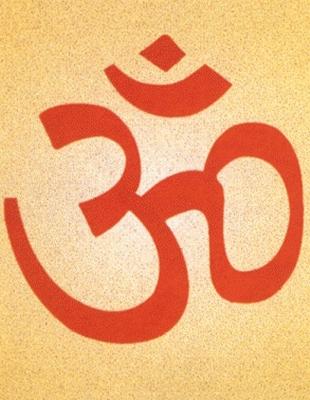 The letter or symbol OM or AUM is always at the beginning of mantras; for example AUM MANI PADME HUM. AUM is the beginning. AUM is the invocation to call the Divine.
The letter or symbol OM or AUM is always at the beginning of mantras; for example AUM MANI PADME HUM. AUM is the beginning. AUM is the invocation to call the Divine.
AUM represents the three primary forces, the trinity above; they are encoded in AUM, which is Ganesha, the power of the trinity manifested.
When we talk about the unmanifested level of the Absolute, we are talking about Nirguna. Remember I explained in the first two lectures that Guna means a modality of nature or Prakriti, and there are three Gunas (sattva, tamas, rajas). The unmanifested level of those Gunas are Nirguna, which is the superior level of the Prakriti.
When Nirguna moves into activity and manifests, it becomes Saguna, which refers to manifested modalities of Prakriti.
So, visualize unmanifested forces (Nirguna) emerging into manifestation (Saguna). Thet boundary between the two is made possible by AUM. The emergence of unmanifested light and sound into manifestation is AUM, Ganesha, the spirit emerging out of creation. If you have studied Kabbalah, this is the son of God who comes through Daath in Briah.
Ganesha, OM, represents all of that, which is why Om or AUM is the root mantra of so many religions, even in the West. Millions of religious people say Aum every day, but as AMEN, which is AUM-EN (אמן).
The AUM or OM as a symbol contains in itself all the modalities of our own consciousness. Each detail of that symbol represents something in us; for example, the little dot at the top represents our true nature, our Innermost. That spot or dot is the sephirah Kether, which emerges out of the Absolute from our AIN SOPH, and from that emerges the rest.
Skanda, the Brother of Ganesha
It is interesting that in Hinduism Ganesha is represented as having a brother; his name is Skanda, among many other names, like Kartakeya, Subramanya, or Murugan.
In this drawing, Shiva represents the Third Logos, part of the trinity above, and we see his wife Parvati or Uma, and on her lap her two children, Ganesha and Kartakeya.
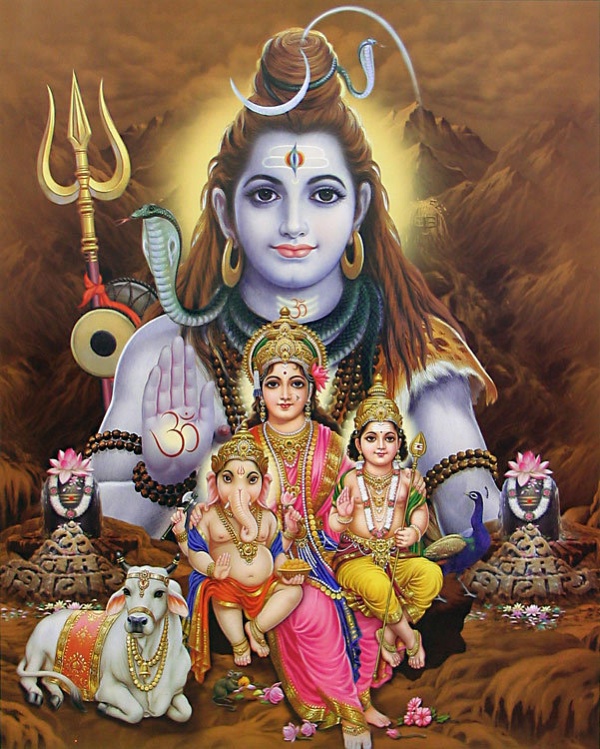
On Shiva you can see the trinity several times, not only the trinity of his staff, but the trinity on his forehead and the OM on his palm; those are all his powers, which he passes through his wife Parvati into his children.
Kartakeya or Skanda is the God of war in Hinduism. Here we find a very beautiful symbol, which, if you have studied Kabbalah, you can immediately start to see what this all means. Ganesha is related with Chesed (Mercy, Jupiter) and Skanda is related with Geburah (Severity, Mars).
Ganesh as the lord of knowledge and wisdom is the chief general of Shivas armies. His brother Skanda is also a God of war and a general of Shivas armies. What sort of war are we talking about? It is the war of The Mahabharata, in which Krishna advises Arjuna to battle against himself. This is the real jihad: a spiritual war against our inner defects.
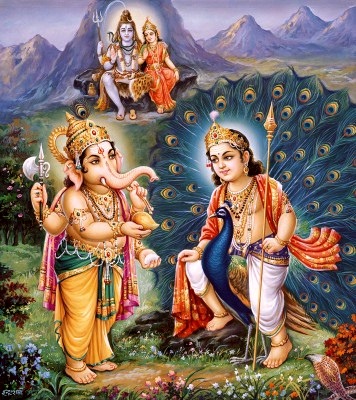
Ganesha and Kartikeya
The generals that lead the armies of God are Ganesha and Skanda. This symbol is not unique to Hinduism; we see these two brothers who work together in other traditions also. I mentioned Egyptian mythology in which we see Horus as the agent of the Divine; his brother is Seth.
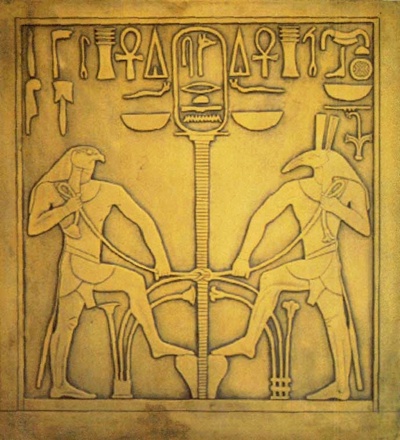
The conflict and ultimate resolution of that relationship provides the dramatic background for the Egyptian mysteries. In Egypt, Horus and Seth have been represented in many ways, but in this particular image you can see them as equals, both pulling on a central rod, a djed. The djed represents our spinal column. Horus and Seth represent forces or energies, archetypes in us, that are working to stabilize our spinal column, to make it stand upright. The way they do that is by playing off each other. In the Egyptian mysteries, Seth places obstacles and Horus overcomes them. This is all embodied in Ganesha.
Ganesha places obstacles and also overcomes them. In this sense, we can see he works hand in hand with his brother Skanda.
We do not have time today to go in detail into the story of Skanda, but we might in a future lecture.
Abraham / Chesed
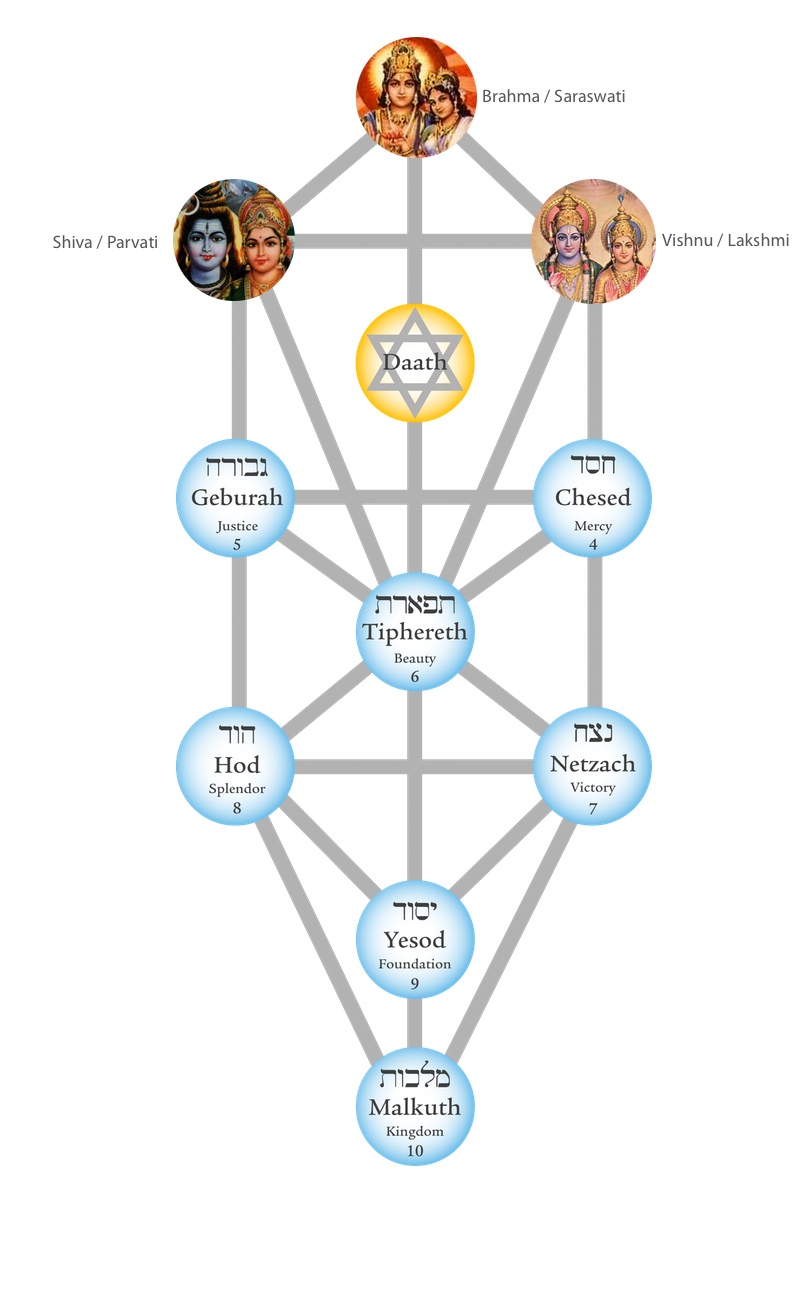 Ganeshas counterpart in the Jewish tradition is Abraham. Abraham or Ibrahim is the great patriarch or founder of Judaism, Islam, and Christianity. These three great world religions are all due to Ibrahim, Abraham—in other words, Abraham is Ganesha, "a lord of hosts." Abraham is the father of many generations of spiritual devotees, and thats why in the Bible it says;
Ganeshas counterpart in the Jewish tradition is Abraham. Abraham or Ibrahim is the great patriarch or founder of Judaism, Islam, and Christianity. These three great world religions are all due to Ibrahim, Abraham—in other words, Abraham is Ganesha, "a lord of hosts." Abraham is the father of many generations of spiritual devotees, and thats why in the Bible it says;
"Neither shall thy name anymore be called Abram but thy name shall be Abraham for a father of many nations have I made thee"
Abraham, Ibrahim is Ganesh of the Western traditions. The Zohar says:
"When Abraham appeared, as he is the secret of Chesed..." - Zohar
Chesed is the fourth Sephirah from the top in the Tree of Life.
When we talk about how the ray of creation unfolds on the Tree of Life, we explain that the upper trinity creates through the third Sephirah, Binah (Shiva-Parvati). That process of creation is symbolized in Hinduism and Buddhism as two gods united sexually, and in Judaism, in Kabbalah that union is called Daath, which means knowledge, that is the nature of Tantra. Judaism represents this as the Ark, which had two gods united sexually. You can read about that in the Talmud.
Daath is a hidden Sephirah between the upper trinity and the second trinity. Daath represents the secret knowledge of sexuality related to the Divine, the union of god and goddess (El + Eloah = Elohim). Daath results in creation, but divine creation, immaculate conception, a way of giving birth in a superior level which has nothing to do with our animality. The result of that sexual creation is represented symbolically in the Kabbalah as Chesed, the fourth Sephirah, Abraham.
Symbolically speaking, Abraham is an archetype; that is Abraham in us. In the concepts of Hindu psychology, Abraham is related to Atman, which means "self." This "self" is not the sense of self that we feel here, physically; rather, it is our Spirit, our "Father" who bestows his gifts upon us. In other words, Ganesha.
The Wives of Ganesha
The reason this is important to understand is because of Ganesha's name Buddhipriya. Buddhipriya means "fond of Buddhi" or "husband of Buddhi." When Ganesh is represented as having a spouse, one of the representations is his spouse called Buddhi.
Buddhi is a Sanskrit word that means wisdom. It can also be translated as intellect or intelligence.
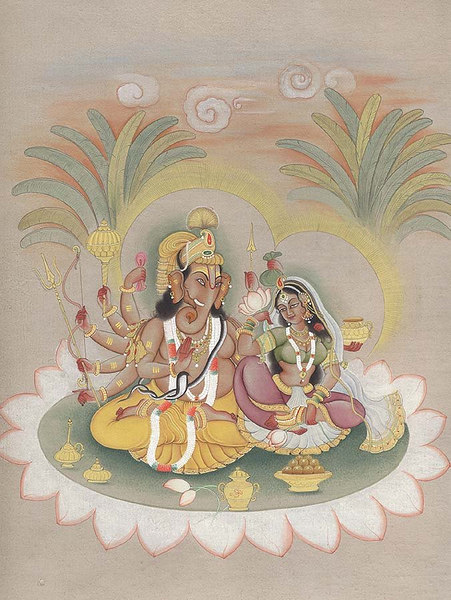
Ganesha and Buddhi
Sometimes Ganesha is represented as having three wives: Buddhi, Riddhi, and Siddhi. These are all symbolic. When we see stories and representation of the gods having multiple wives, they are not committing adultery, these are symbolic representations of divine forces moving deep within our consciousness.
- Buddhi means wisdom, knowledge, or intelligence
- Riddhi means prosperity
- Siddhi means powers or attainment
This symbolism is part of the reason why people in the exoteric levels of religion have taken Ganesha as their deity or God, because they want material prosperity; so you may find images hanging in shops, banks, and restaurants that have Ganesha and Lakshmi standing side by side. Lakshmi is the goddess of prosperity, and Ganesha is the god of prosperity; businesses want to make money, so they think if they hang a picture of the gods there, the gods will be very impressed and give them money. Life does not work like that.
Really, Riddhi means spiritual, karmic, or dharmic prosperity. How do we acquire dharmic prosperity? Through self-knowledge, through Kriya, which is action: spiritual action.
Siddhi means attainment or powers. Siddhis are the powers of the consciousness. Powers are given to us by our inner Ganesha. Powers have to be earned. Powers include the ability to have Samadhi, the ability to astral project, to awaken the chakras, to remember our past lives, to have telepathy—in short, to have all the different types of spiritual powers that we love to read about. Powers have to be earned, and are granted as a boon by God. They can never be earned by any kind of trick, through any kind of clever technique, by hanging up a picture or repeating a bunch of words over and over. Why would God be impressed by that? God cannot be fooled. God bestows gifts on the one who earns them, who deserves them.
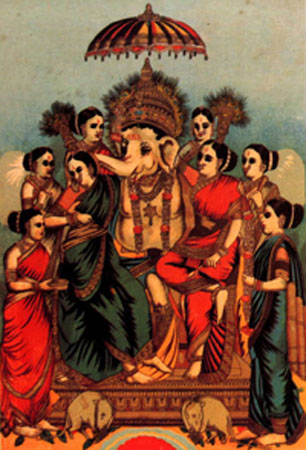
Ganesha and the Siddhis
Buddhipriya as a name of Ganesha shows that he is married, united to, or in love with Buddhi, wisdom, knowledge. Again, I repeat, this is symbolic. It does not mean that there is an elephant headed guy in heaven who is married to a girl named Buddhi. No! This is symbolic of our psychology. When we study the Tree of Life, we see what Buddhi is on the Tree of Life: it is the fifth Sephirah down the Tree of Life, directly across from Chesed.

Ganesha the King
In Hebrew, the fifth sephirah is called Geburah. The two sephiroth Chesed and Geburah represent two very subtle but very important aspects of our inner psychology.
The sephirah Chesed is known in Hinduism as Atman, which means "self." Chesed is our Spirit, what in the Bible is called "the Father"—our inner father, not the divine, unmanifested, ultimate level, the father of the universe, no. Chesed / Ganesha / Abraham / Atman is our personal, inner Father, our inner Guru, our inner Divinity, our source, our spark, our true inner self, who also has his own true inner self, which is the unmanifested. Atman is our inner Buddha. Atman is Ganesh.
When he is born of Shiva-Shakti, Ganesha (Atman) expresses from himself Buddhi (his wife), which is his knowledge, his wisdom. The spouse is "the Divine Soul," our Divine Consciousness, which in other religions is represented as Helen of Rroy, Euradice, Beatrice from The Divine Comedy, and many more. In the Arthurian legends, our innermost or Chesed is represented by Arthur, and his wife, Buddhi, is Guinevere.
In Kabbalah we understand that Chesed has important planetary significance related to our psyche. One of the important planets related to Chesed / Ganesha is Jupiter. Jupiter is the king, the royalty; that is Ganesha, the king or master, the ruler of the armies, the one who is in charge in our spiritual universe. Ganesha / Arthur / Atman is our inner king whom, unfortunately, we have betrayed.
Another name of Ganesha is Buddhidatta, which means" Giver of Buddhi." In other words, when we want to acquire spiritual knowledge, direct experience of the Divine, to talk with God, we need Buddhi, wisdom, spiritual knowledge related to the Divine Consciousness, and that is given by Ganesha, our Innermost, our Atman. Only he can give such gifts, not only as our soul is created, but through our spiritual experiences, through our spiritual enlightenment, our spiritual development. The knowledge and wisdom that we acquire comes from Ganesha, our Innermost.
How does that come? Through overcoming obstacles. Ganesha is also named Vighnaharta, "the one who places obstacles." What are our obstacles? Our psychological defects. External obstacles only challenge us when they activate an internal, psychological obstacle: our fear, lust, pride, envy, laziness, etc. When we have to face our internal obstacles and overcome them, our inner Ganesha removes them and gives us Buddhi, knowledge, wisdom, understanding, comprehension. This is how one becomes wise. Only by facing and overcoming ourselves do we acquire genuine spiritual awakening. That is to acquire Buddhi.
Sarvatman: The Whole Person
So let us review this: here we see all these symbols on the Tree of Life.

- The upper trinity, Brahma, Vishnu and Shiva and their spouses
- Daath / Tantra is that level through which the upper trinity creates, in which the three in one becomes two in order to unite and create
- Their creation is Atman / Ganesha / Abraham / Horus / Chesed
- Through all of the power he inherits from the trinity, emerges his knowledge, which is Buddhi
This review can help you understand another name for Ganesha, which is Sarvatman, which means literally, "the whole person."
Many Hindus wonder, "Why is Ganesha called 'the whole person'?" Now you know why. because our true identity, our true nature as a whole person, is to be united with these high, spiritual levels. Right now, we are not. A truly whole person—an enlightened person—is united with their inner Ganesha, and Buddhi, and Shiva, etc. Such a whole person is someone like Buddha Shakyamuni, Jesus, Milarepa, etc. We have a long way to go to become "whole."
Genuine success in life is not to have money, it is not to have the latest fashion or to be successful materially in the world, it is to be united with our inner God. That union is based on direct knowledge of these levels inside of ourselves. A truly whole person is an embodiment of their divinity; such a person is Sarvatman. Such a person is like Buddha, Krishna, or Rama, someone who truly is a whole person, whose every action embodies the virtues of the Gods—not merely talking about those qualities or admiring them but IS those qualities. In such a person there is no distinction between themselves and humility, because they are humility. They are pure chastity, pure happiness for others, pure compassion, pure intelligence, pure wisdom.
Such a person is Sarvatman, a whole person. Until we have acquired that, we are not whole, and that is why we always feel that something is missing, an "emptiness," something lacking inside. We are always trying to fill that feeling of emptiness with material things, with sensations, with going here and going there, with traveling, with buying things, with selling things, with making a profit, but all of those pursuits are a reflection of our deep ignorance. The only thing that can fill our heart and soul and mind is our inner Divinity. The purpose of life is for us to unite with our inner divinity, and become that, then we become Sarvatman, a whole person.
Spirit, Soul, and Body
We can see this on the Tree of Life. The upper triangle represents levels of Divinity that are hard for us to grasp because they are subtle and beyond our immediate perception. Below the upper trinity we see the seven sephiroth; as we explained in the first lecture of this course, these seven represent the manifested level of Prakriti. They represent our spirit, soul, and body. Unfortunately, they are impure in us because of our Avidya, our ignorance. But if we work to purify them, we could unite all of the sephiroth as one, and that is self-realization: to know the entirety of oneself, not just as a theory, but through direct knowledge, through Vidya. In Sanskrit this is called Brahmavidya, "knowledge of God," but that is not theories or beliefs about God outside, it is experiential knowledge of God inside of ourselves.
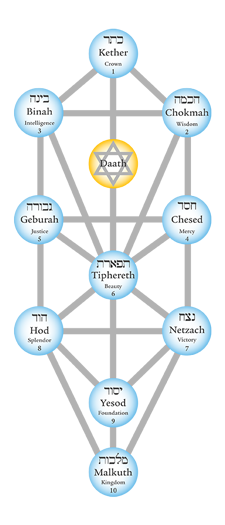 In Kabbalah, these seven lower spheres that represented our spiritual, soul, and body are:
In Kabbalah, these seven lower spheres that represented our spiritual, soul, and body are:
- Chesed
- Geburah
- Tiphereth
- Netzach
- Hod
- Yesod
- Malkuth
The top one is Chesed, which is our spirit. In Hindusim, Chesed is represented by Ganesha. This is Atman, our "self."
The next is Geburah, represented by Buddhi, and this is our Divine Consciousness, which is the repository of Gods knowledge—not our knowledge, not our intellect, but the Buddhi of Ganesha.
Just below that on the Tree of Life is Tiphereth; this is willpower, the human soul or human consciousness. What we experience as awakened consciousness is related to Tiphereth. This is part of ourselves that we do have some degree of knowledge; this is our willpower, our volition. Unfortunately, our volition, our willpower, is trapped in desire. Our willpower is caught up in the will to survive, the will to succeed, the will to acquire money, fame, or recognition, to be respected, to be loved, to be honored, etc.
Very little of our will is focused on God. If you do not believe that, look at how you live your life from day to day: how much of your thoughts, feelings, and actions are purely focused on knowing God? You might be doing other things, for example, when you wash the dishes are you remembering God? When you are at work, are you remembering God? When you are watching that man or woman walking down the street, are you remembering God? How often do you maintain a continual, moment to moment remembrance of your Innermost Divine? That observation of yourself will tell you how much willpower you have free of desire.
We say that the average amongst modern people is 3% not yet trapped in desire. Only a fraction of our consciousness is unmodified by desire. Every once in a while, that little fraction will get enflamed with enthusiasm for spirituality, and we may have some experience of the Divine, whether in a waking state or in a dream state, but very quickly that experience is converted into fanaticism or fear, that longing is converted into politics, into fighting amongst groups, and worse. It is very rare for anyone to preserve intact that small fraction of free will that sincerely longs to know Divinity, and will sacrifice anything to have it. Most people who make sacrifices in a spiritual way do it for selfish purposes. It is rare for someone to make spiritual sacrifices without having a hidden purpose. Many people become "religious"—even becoming monks or nuns—because they do not want to work, have a regular job; they do not like society, they want to escape their pain and suffering. It is not really about God for them, it is about selfishness. For them, being "religious" is not really about serving others, it is really about serving themselves. Many people join a church, temple, school, or movement, not because they sincerely want to know God, but because they are tired of being in pain, or they are lonely, or they want to stand out in the crowd. We have to be sincere with ourselves, and analyze our behaviors to really understand who we are, so that we can truly change. As long as we have illusions about ourselves, especially spiritual illusions, we will remain suffering in Maya, in illusion.
The next Sephirah is Netzach, which relates to the mind, to the intellect. It is also called the mental body. This connects with our physical brain.
The next is Hod, which relates to the Astral body, to our emotions.
Then we have Yesod, which is our vital energy.
Finally, Malkuth is the physical body.
These Sephiroth are multi-dimensional. Only the bottom one, Malkuth, is third dimensional. The rest are not physical. They connect to our physicality, because all of these dimensions interpenetrate each other. We have feelings, emotions—if our heart is able to sense any feelings—those feelings that we sense are reflections of what is happening in Hod, in the Astral body, which is in the fifth dimension. The thoughts that we sense physically are a reflection of Netzach, the mental body, which is in the fifth dimension. Likewise, will or Tiphereth is in the sixth dimension; when we have impulses to act and to do things, those impulses to act and do things are our willpower, but unfortunately, that will is usually modified, its usually reflected through thoughts and feelings that are corrupted with desire.
So what does all this mean? It means we need the help of Ganesha, our Innermost. Without the help of divinity, we are lost.
Ganesha in Buddhism
Buddhism came from Hinduism. If you want to understand Buddhism, you must understand Hinduism, because internally they are the same tradition. Hinduism is the root symbolism that nurtured and fed the Buddhist traditions all over the world. There are many Buddhists who reject Hinduism—to their own detriment—and they fail to learn genuine Buddhism because of that. When you put your mind in a box, you remain in the box, too. Genuine spiritual awakening is a process of freeing our mind from all kinds of cages.
Ganesha is known in all forms of Buddhism—except some modern forms (such as "modern" Zen) that have extracted almost everything out of their traditions. They are desiccated remnants, lifeless shells.
Ganesha represents the obstacle placer and the obstacle remover. In Buddhism, this is how is he primarily studied nowadays.
Buddha Shakyamuni himself taught about Ganesha. There is a sutra in which the Buddha Shakyamuni teaches the mantra of Ganesha and the reason he teaches the mantra is in order to remove obstacles.
Here, we will provide you with the entire text. This is The Essence of Ganapati-Ganesvara (Sanskrit: Aryaganpatihridaya; Tibetan: 'Phags pa Tshogs kyi dDag po'I sNiying po):
"Homage to all the Buddhas and Bodhisattvas.
"Thus have I once heard:
"The Blessed One was dwelling in Rajagriha together with a great community of 1250 monks and of Boddhisattva-Mahasattvas. At that time the Blessed One spoke to the Venerable Ananda, 'O Ananda, the tasks of anyone who comprehends the Essence of Ganapati-Ganesvara will all be accomplished. One's wishes are fulfilled by comprehending it and every mantra will bring attainment:'
"'Tadyatha / Namo stute-maha-ganapataye svaha / Om kata kata / Mata mata / Dara dara / vidara vidara / Hana hana / Grihna grihna / Dhava dhava / Bhamja Bhamja / Stambha stambha / Jambha jambha / Moha moha / Dehi dehi / Dapaya Dapaya / Dhana dhanya sidhi me prayaccha samaya-manu-smara maharudra vacaniye svaha / Om kuru kuru svaha / Om turu turu / Om muru muru svaha / Om bava samti vasu pushtim kuru svaha / Adguta bindu kshabhita mahavidara / Sama-gacchati mahabaya / Mahabala / Mahavarakra / Mahahasti / Maha-dakshini-ya praci-dayami svaha / Om kuru kuru / Curu curu / Muru muru / Om ga ga ga ga ga ga ga ga / Om namo nama svaha
"'Oh Ananda, when any son of noble family, daughter of noble family, monk, nun, lay man or lay woman goes to a place of worship other than where the Three Jewels (are worshipped) or enters the palace retinue of a king and practices the mantras (recited in that place) and begins with this Essence of Ganapati-Ganesvara all one's tasks will be accomplished. Have no doubts about it. If one is mindful (of this mantra) in fights, arguments, confusions, and wars, they will all be pacified. If you get up early each morning and recite it, you will attain learnedness. Yakshas, rakshasa and dakini will not rob your health but will promise to stay far away.'
"After the Blessed One proclaimed these things, the gathering and everyone in it, along with the world with its gods, men, demigods, and gandharvas, rejoiced and praised the Blessed One's teaching. This completes the Essence of Ganapati-Ganesvara."
Buddhism does not exclude Ganesha, and does not disparage Ganesha. Buddhism is built on Hinduism and on the knowledge of Ganesha. In fact, if you have studied Chinese or Japanese Buddhism, or Chinese/Japanese religions in general, you will find that most of the gods came from Hindu gods, and the names have just been altered to fit the language of each location. Ganesha is no exception to that.
This first image represents how to overcome obstacles. This image is an ancient Buddhist painting of Vignantaka trampling Vinayaka.
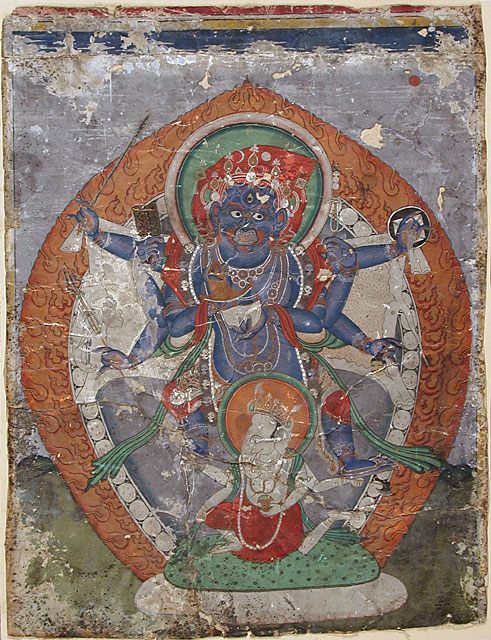
Some foolish people have interpreted these images to mean that Buddhism has trampled Hinduism. This is false. What these stories actually represent is Shiva (Mahakala) teaching his son the path to liberation.
The blue-skinned deity is Krishna (which means "blue" or "black"). Krishna is Christ. Krishna is the solar Logos, the upper trinity, Krishna is the Trikaya of Buddhism: Dharmakaya, Sambhogakaya, Nirmanakaya. Krishna is Brahma, Shiva, and Vishnu.
This blue skinned deity is Krishna as Shiva. He represents the power of divinity on the unmanifested level, the archetypal level, who is going to create. For him to do that, he has to overcome the obstacles, and those obstacles are karma. What karma? Ours! Our inner Shiva / Krishna has to find a way to overcome the consequences of our mistaken actions from our ignorance, which have created a huge problem for our inner Divinity. Our inner Divinity (Yidam) needs to advance spiritually, but cannot because of our stupidity. Yes, God needs us. Our Innermost needs us in order for our Innermost to advance.
So, our inner Shiva, who in this case is called Mahakala, is teaching his son (Ganesha / Atman) about how to dissolve the ego, how to eliminate obstacles. That is what these images represent. Shiva / Mahakala stands on top of Ganesha to teach him about the ferocity and energy needed in order to overcome obstacles (karma, ego), in order to advance spiritually.
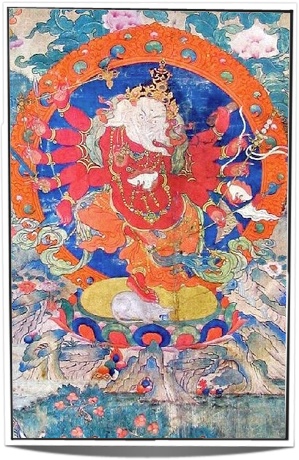
The second image is Ganesha doing what he was taught. He is called Maharakta (Tibetan: tsog gi dag po, mar chen) "The Great Red Lord of Hosts." The red color is all the fire and passion in action, the energy of Divinity, and that red is feminine, it is the power of the Divine Mother, it is Durga, Candali, Tummo. That is why we see the red flames around them all, and the red skin on Ganapati or Ganesha.
These images are very important in Tantric iconography, because they teach us how we need to eliminate our obstacles with the help of our inner divinity.
Kanguten
In Japan, Ganesha is known in a secret tradition that is not widely known, in which Ganesha is known as Kanguten, which means "deity of joy." This tradition is very secret; it is very difficult to find any representations of Kanguten, because traditionally these images were always kept in secret temples, in private, and only initiates, people who have taken vows, not only could see them, but knew what they meant. Due to our ignorance and psychological decay, like every other tradition the tradition of Kanguten has degenerated into a form of black tantra that has spread in many places. The original form of Kanguten is related with white tantra.
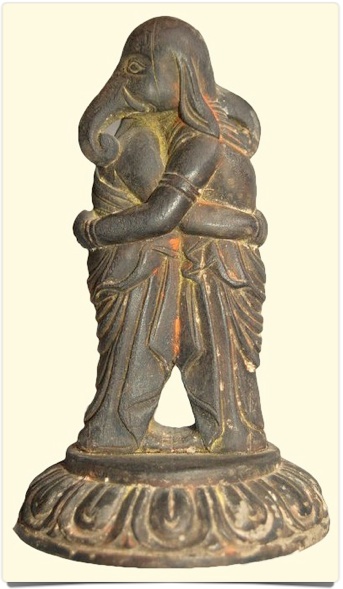
In this image, Ganesha is shown embracing his wife; this image was kept in secret in temples in China and Japan as a representation of the tantric mysteries through which a couple would collaborate in order to harness the power to overcome obstacles. Nowadays, this has degenerated into object worship, in which couples collect these statues and pray to them so they can have children, or they can have financial success. That is a degeneration. That is not the genuine tradition of Kanguten. That is a deep misunderstanding of the original purpose of these symbols.
Ganesha and the Swastika
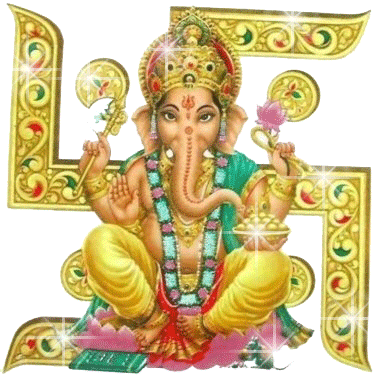 The real meaning of Kanguten can be found when we understand Ganesha in relation with his other primary symbol, which is the swastika.
The real meaning of Kanguten can be found when we understand Ganesha in relation with his other primary symbol, which is the swastika.
Ganesha has some very significant symbols: the OM and the Swastika.
The swastika is a four armed cross in movement. If you have studied Gnostic tradition, you know that the cross is a sexual symbol that represent the crossing (+) of male and female, and when that cross moves, it spins and becomes this symbol (卐). The swastika is the cross in movement. The swastika represents the power of the Third Logos, the Holy Spirit in action.
The reason this is important in relation with Ganesha is because firstly, he is the outcome of the swastika in movement in the superior worlds, when Shiva and Shakti unite; their child is Ganesha, the Innermost, Chesed, our Atman, our true inner Buddha. In other words, this is why we see the swastika on images of Buddhas, especially Amitabha. Images of Amitabha generally have a swastika in his chest. Jain sculptures also have this.
In Asian symbolism, the swastika is a 100% positive symbol. Unfortunately, the Nazis in Germany appropriated it and corrupted it, like we have done with so many symbols. But, the swastika itself does not mean anything evil. In fact, it is probably the most sacred symbol in Hinduism. It is a symbol of good luck, prosperity, creation, growth, evolution, goodwill. It is the most positive, prosperous symbol in Hinduism. That is why its related with Ganesha; Ganesha is the one who brings prosperity, who overcomes obstacles, and who connects us to God.
What connects us to God is the power of the cross in movement, the crossing of male and female in movement. When the sexual energy is preserved in the cross, when the energy is not wasted thorugh lust or animal desire, when the energy of the cross is preserved and sanctified, when it is held as Divine, what is the outcome? It is an immaculate conception, creation of the soul, of virtue, of the spirit.
This is the reason why Yoga requires Brahmacharya. Brahmacharya comes from Brahma, "the ultimate divinity," and charya, "to follow." Brahmacharya is sexual continence: the restraint of the sexual energy, or in other words, to not have the orgasm. This is "to follow Brahma."
Genuine spiritual development depends upon restraining the sexual energy in order to utilize that power for our liberation.
"Brahmacharya literally means Achara or conduct that leads to the realization of Brahman or one's own Self. It means the control of semen, the study of the Vedas (scriptures) and contemplation on God. The technical meaning of Brahmacharya is self-restraint, particularly mastery of perfect control over the sexual organ or freedom from lust in thought, word and deed." - Swami Sivananda
Brahmacharya has two levels. The first is the level at which someone first enters a religion and as a single person learns to restrain the sexual energy in order to purify it and control it. The second level is when that person enters into a marriage and they learn to work with that energy in order to preserve it and elevate it, to make it a vehicle of Divine forces. The swastika represents that. Our inner Ganesha is the one who makes it possible.
The sexual energy is at the root of the spine. The sexual energy is that energy that gives us life and allows us create life. It is at the root of the spinal column.
When we look at the human body, we see the spine goes from the sexual organs to the brain. Spiritual development depends upon the sexual energy being purified and rising up the spinal column. For it to begin that process, it must leave the base of the spine where it is contained, and that place is called the Kanda, which is a region of nervous filaments at the base of the spinal column that connects together many nerves or Nadis in the body.
That energy is encapsulated in what is called the Muladhara chakra, an energy vortex at the base of the spine. Mula means "origin or root." In the previous lecture we explained Mulaprakriti, which is "the root of nature." That energy of nature has static (inactive) and kinetic (active) levels. In us, the energy of the Divine Mother (the fire of the Holy Spirit) is static, it is latent, it is asleep. When we learn the secret knowledge of sacred sexuality (white tantra), we learn to restrain the sexual energy and activate it through our devotion to God, our charity, and through our sanctity, that energy can be activated—in other words, the static energy can be converted into kinetic energy. Who does that? Ganesha, the Lord of Beginnings, whose symbol is the swastika. The swastika, the four armed cross, is the Muladhara chakra, which has four petals, and the symbol of the Muladhara chakra is an elephant, which is Ganesha. The power that is trapped in the Muladhara chakra is the power of Shiva and Shakti. For that power to be awakened, Ganesha has to do it, and Ganesha will only do that when we earn it.
We earn the awakening of the fire through the application of the science and the overcoming of obstacles. With the awakening of that fire, it can begin to rise in the spinal column. That is how we acquire the three consorts of Ganesha:
- Buddhi: wisdom
- Riddhi: prosperity
- Siddhi: attainment
This is how Ganesha and his wives become active in us, through the spinal column, level to level, up the vertebrae, through the chakras, but it begins in Muladhara. That is why Shivananda explained:
"Without the grace of Sri Ganesha and His help, nothing whatsoever can be achieved. No action can be undertaken without His support, grace or blessing." - Sivananda
Ganesha represents our Innermost, our Atman: without his grace, we cannot accomplish anything spiritually. He is the Lord of Beginnings. This is why in the Gnostic tradition we always emphasize self-remembering: to remember God continually, from moment to moment, to always remember the inner Self, to always—whatever we approach as an action, whatever we want to do—ask that it be done in accordance with our inner God. When we say a prayer, when we say a mantra, we always say "May thy will be done." That will is the will of Tiphereth. If we look into the Tree of Life, we see this middle triangle, Chesed, Geburah, Tiphereth. Chesed is Atman or Ganesha. His knowledge, his wisdom is Geburah. His will is Tiphereth. So when we say, "Yhy will be done," it is an invocation for him to act through our Tiphereth, for him to do what must be done, for his glory, not for our own.
Unfortunately, we take that will and corrupt it. We might say, "God, let your will be done," but then we do what we want to do anyway.
If we want to really understand something about Ganesha and these symbols, we can begin with that: learning how to remember God, praying to God, with whatever we do, whatever we want, whatever we will to remember God.
Questions and Answers
Audience: If we go back to the image of the whole man, you could superimpose the five pointed star over that?
Instructor: Yes, the Pentagram fits into the Tree of Life a number of ways, and that is one way, as Sarvatman.
Audience: What is the Pistis Sophia's place in the Tree of Life?
Instructor: The entire Tree of Life is represented throughout The Pistis Sophia. Everything that happens in Pistis Sophia encompasses the entire Tree of Life. So if you look in that text and you study it, you will discover that all of the repentances, all of the aeons, relate to Sephiroth on the Tree of Life, and that would take many lectures to explain. That is why we have a big, thick book about it. I recommend reading that and studying it. There are some graphics in the Glorian edition that help explain how the Tree of Life relates to the teachings in that book.
Audience: During most lectures I usually hear the most important thing, this is your Self; how does Ganesha differentiate from other times you have said something is our true self?
Instructor: That is a good question. In every lecture, we talk about knowing yourself, and this time we are saying that self Ganesha. How does Ganesha relate to that self and how do we understand that? Firstly, let me explain that Ganesha is simply an archetype—in other words, a symbol. Ganesha is a form that God uses in order to teach us. In every pantheon and every region of the world, God unfolds in different ways in order to teach the people of that region according to their psychology; in the Aztec culture those people who were serious about learning about God perceived impressions of Divinity through their spiritual experiences that related to them psychologically, so they saw Quetzalcoatl, they saw Kukulcan, and they saw different symbols depending on what they needed to understand in relation with their psychology and their karma. Similarly in Hinduism, serious spiritual aspirants have been shown forms and images of God related to their psychology and that relate to their culture, so that they can understand what those things mean in themselves. Ultimately, all of these symbols convey the same meanings and have the same importance. That is why we explain that throughout all these different traditions, all of these different symbols point to the same thing. We have students from every religion; some students will feel more affinity with Hinduism, some with Christianity, some with Judaism, and they should use those symbols that they feel drawn towards and feel natural with, because we do not need additional obstacles in our spiritual work. We need to work with the forces and energies from above that correspond with our own psychological idiosyncrasy.
We are talking about Ganesha in this course because for those who have the idiosyncrasy of feeling close to Southeast Asian mythology, that symbol is very accessible for them, whereas for someone who does not have that background, it may seem very foreign. We point this out so that you can understand that these symbols are simply that: they are just symbols.
The reality is that our self has no form (atman is anatman). Atman is formless. Atman is a expression of God at a certain condensation or crystalization of nature at a very superior level, and that level, that form of God can appear to us in many forms. In my personal experience, I have seen my Atman—not that I am special, I am not better than anyone else or deserve anything more than anyone else, but because of my work spiritually. I have been granted that vision a few times, and he has looked different every time, from different religions, and that is probably because in my past lives—because I have been a bad person, I have lived in many cultures all over the world, and had these idiosyncrasies, at different times, with different traditions, so now I love all religions, partly because of that; so he shows me those images of himself for that reason, partly so that I will understand that, and secondly so that I will not get attached to one or another image. Ganesha is just an image of something that ultimately is without an image or form
Let me point out something really important about that. As much as we need to pray to God, grasp at God, and long for God, we need to do it in the right way—not building idols of God in the mind, or the heart, not to build images or structures, or beliefs or concepts of God, but instead to get rid of all of that and open the heart and mind to the reality of God. This is different. There are millions and millions and millions of people in the world who have built huge cathedrals in their minds and hearts to God, but there is no God there, because that psychological construction is man-made, and filled with ego. Samael Aun Weor said something very beautiful that sticks with me always:
"God seeks out the nothingness in order to fill it."
When we are full of something, there is no room for God. If we are full of an image of God that we have made, or full of attachment to a particular tradition, there is no room for God. We need to open the heart and mind in order to perceive the reality, to not project an image as a construct or as an idol but to use the images as doorways. If you take any image of Divinity and meditate on it properly, it will open up and show you new things. But unfortunately, what most people do is they meditate on the image but they try to hold it together, they try to make it rigid and very limited, they constrain it, so they constantly make effort to make it a form, instead of letting it change and letting it open up. There is a kind of flexibility that you need in your visualization practice in order to understand what that means.
Audience: You mentioned the pentagram in the Tree of Life; I think you meant the hexagram in the union of the two trimurti through Daath?
Instructor: When we study the Tree of Life, we see every type of geometric shape. In Daath, we do see two triangles united, but surrounding that from Kether to Chesed to Binah to Chokmah and back to Geburah you can see a pentagram. This is part of the geometry of God. Really, again, the Tree of Life and that structure is simply symbolic. Every type of geometrical shape exists in nature, because they are all made by God, and the Tree of Life can be disarranged and rearranged in many ways according to what we are trying to understand. We should not be limited by the symbolic structures. Audience: Could you explain the name Jehovah on the Tree of Life?
Instructor: The name Jehovah on the Tree of Life has many meanings and correspondences. In particular, it relates to the upper triangle. Jahovah or Jahavah relates to Adam and Eve, the primordial creative force of Shiva-Shakti. To go deeper into that, we have hundreds of lectures and some sixty or seventy books that talk about the different aspects of Jehovah and the different meanings, especially the book The Secret Teachings of Moses, which I would recommend as a very good introduction to the meanings of the Hebrew names of God.
Audience: You mentioned Deity Yoga; is that related with how we practice theurgy, or is that something different?
Instructor: Yes its closely related. Strictly speaking, Deity Yoga is a Tantric tradition that is most known in Tibetan Buddhism, but its actually a part of any Mahayana level or higher type of teaching. Even in Hinduism there is Deity Yoga in certain groups. Deity Yoga strictly defined refers to a Tantric technique in which a person visualizes themselves to literally be their deity.
Deity Yoga is a different, more secret level from the beginner level of Bhakti Yoga. Bhakti Yoga, which is common in Hinduism and Buddhism, teaches the person (just like in Christianity, Islam, or Judaism) to worship God as an outside being. The person sings songs, mantras, bhajans, kirtans, and does devotional practices as an expression of love for God, as a demonstration of devotion to Jesus, Krishna, Shiva, or any other representation of Divinity. The next level up is Deity Yoga, in which the person literally begins to visualize that they are that God, and that God is them. This is in order for us to learn about virtue, so that we stop being so identified with the ego, because right now we are very much identified with our pride, with our lust, with our anger, and we feel very disconnected from God, so through the practice of Deity Yoga, you visualize and imagine in your meditation practice that God is in you, and you are that God. That is a way of starting to look at the ego from a different perspective, so that you see it for what it is. It is a very powerful technique, but its very dangerous for those who are not properly trained, because they can build a lot of pride, and can start to think, "Well, I am that God, I do not need to change, I am already that God. I am what I am, I am what He is. I have nothing to eliminate in me, because I am Him." There are many people who believe that (even though they may not call this Deity Yoga). They sincerely believe it, and of course they become demons, very, very deceptive demons. So, the importance of understanding that is underscored in the writing and teachings of Samael Aun Weor. He teaches Deity Yoga in a synthesized way in his practices and techniques. There are a lot of meditation practices in which we repeat "I am He." Those are Deity Yoga practices in which we are literally starting to visualize and imagine that God is in us, it is us, we are that. But this must be accompanied by strong, daily work on our ego.
To really understand divinity is not easy for us, because we have so much ego. Being successful in that effort is the basis of Theurgy. True Theurgy is performed by a person who is able to act on the will of God for the benefit of others, not for oneself. Theurgy in that sense means magic or ritual. A Theurgist invokes the power of their Innermost in order to aid others. In this tradition we have hundreds and hundreds of techniques of Theurgy, and theres a book called Logos, Mantra, Theurgy which is packed with exercises in order to develop the ability to become a true Theurgist. That power is 100% contingent on knowing the Innermost, and being able to be a facilitator of his powers. We cannot do that if we are filled with pride, or lust, or anger. He will not come into that environment. He will not empower our anger or our pride, because it will create more obstacles for him, too.
It is interesting that you mention that, because Ganesha has a lot of correspondence with magic, theurgy, and ritual.
Audience: Logos, Mantra, Theurgy, what is that a combination of?
Instructor: Logos, Mantra, Theurgy is currently published in the collection called The Divine Science.
Audience: Would it be better to pray to your Divine Mother all the time instead of using the Deities? Can we use the Divine Mother to represent all, or should we spend time praying to other aspects of God as well?
Instructor: You should pray to whatever aspect or symbol of God pulls at your heart.
When we study Gnosis, when we study religions, we are using the intellect in order to acquire or gather information in order to understand all traditions and all religions, in order to encourage ourselves to penetrate deeper into the truth. But the intellect cannot take us to God. As many images or symbols as we understand or know about the names, and as many hierarchies and pantheons as we have examined and studied and placed them all perfectly on the Tree of Life, that is all meaningless if we have no relationship in our heart with it.
You have to look to your own heart for those symbols and representations of God that call to you. They can be Hindu, Aztec, Nordic, Taoist, Greek, or absolutely formless. The doorway is going to be in your heart. I have friends who are Sufi, and I have friends who are Buddhist, and have friends who are Christians, and all of them use different symbols for the same thing. The symbol is ultimately irrelevant as long as it opens the doors of your heart, as long as you are praying sincerely from your heart; not from your mind, but from your heart. You can use any symbol of Divinity that pulls at you, that calls you, that inspires you.
Audience: So is OM (AUM) the mantra for Ganesha?
Instructor: Yes, OM is the mantra for Ganesha, there are many others, but the simplest is simply OM.
